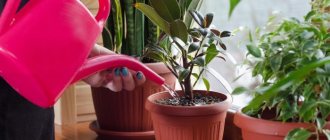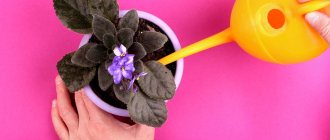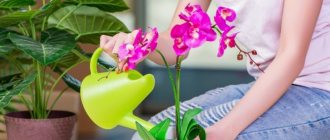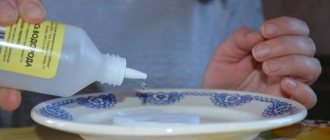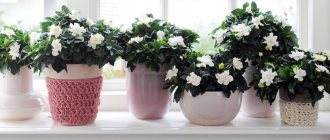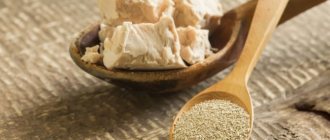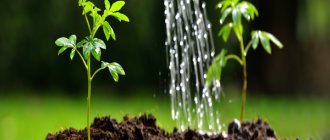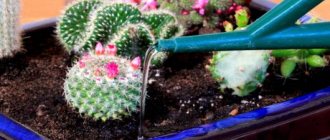The frequency and nature of watering indoor flowers largely determines how quickly they will grow, how luxuriantly they will bloom, as well as the degree of their susceptibility to certain diseases. Another “point” is the dependence of the amount of watering on the season.
It is unlikely that the information that watering houseplants in the warm season is fundamentally different from watering in winter can be called a secret. However, in order to provide your flowers with the liquid they need, more specific information is required.
How often to water indoor flowers in spring
Spring is traditionally considered the right time to replant houseplants. And since this is also the time of the beginning of the growing season, growing and developing flowers simply need a sufficient volume of liquid.
It is difficult to name the specific time interval that needs to be maintained between waterings. In spring, during the period of growth and development, the optimal frequency of watering ranges from 3-7 days, depending on the air temperature outside the window and in the room with flowers, the presence of heating, the degree of air humidity and its circulation.
The main sign that your plants are not getting enough water is dry soil that can be easily pierced with a wooden stick. If the stick easily went several centimeters deep and after removing it you found that it was dry, you can safely water the plant. But this check must be performed very carefully so as not to damage the root of the plant.
Once or twice a month, watering the plants is combined with root feeding. Manufacturers of mineral fertilizers recommend dissolving them in water and applying them at the root once every two weeks in the warm season. In this case, fertilizing should alternate with treatment against diseases and pests, which is also carried out once every two weeks, and it can be both root and foliar. For better growth in the spring, all plants, including domestic ones, require fertilizing with nitrogen fertilizers, and from folk remedies - thick infusions of eggshells or onion peels.
And a little about spraying. This is also a kind of watering, however, some flowers (especially during the flowering period) suffer from liquid getting on the leaves (plants of the Solanaceae family, in particular petunia), and especially from stagnation of water in their axils. In this case, you need to spray not the plants themselves, but the air within a radius of several meters from them.
- Why indoor plants don't bloom and how to fix it
What is the reason that your home flowers have ceased to please you with buds?
The frequency of spraying indoor plants with water without adding other means is also directly dependent on the air humidity in the room. If the heating has not yet been turned off, and it is already warm outside, then you need to spray indoor plants at least twice a week and water the same number of times. This is especially important if your flowers are on a windowsill under which there is a heating device. If the situation is diametrically opposite, then watering and spraying of plants should be increased very carefully, focusing on the condition of the soil (dry or wet) and leaves (if they begin to droop, it’s definitely time to water the plant).
As soon as the average daily air temperature outside the window rises to 10-15°C, some flowers can be safely placed on the balcony (provided that it is glazed). These include, in particular, Ficus Benjamin, Aspidistra, Boxwood, Crassula, Aloe, Kalanchoe, Begonia, Primrose, Hydrangea, Hibiscus, Monstera and Azalea.
- What flowers to plant on the balcony - a list of names with photo ideas
How to place flowers on the balcony: design, suitable types, care tips.
Plants that are afraid of cold air and drafts (orchid, spathiphyllum, anthurium) are better left in the room even in the summer, but they will have to be additionally sprayed. For temporary balcony pets, before the sun begins to shine brightly, it is enough to water and spray them once a week.
Watering house plants
Watering domestic plants should be carried out taking into account their group affiliation.
Plants that require moderate watering. Most decorative leafy indoor plants belong to this group. The standard recommendation is to water thoroughly and frequently from spring to autumn, and water sparingly in winter, allowing the top 1cm thick layer of compost to dry out each time between waterings.
This drying of the surface between waterings is especially important during the dormant period from late autumn to mid-spring.
Plants that require constant moisture from compost. Most flowering plants belong to this group. The compost is kept constantly moist but not wet. The standard recommendation is to water thoroughly whenever the surface becomes dry, but not so often as to keep the compost constantly saturated with water.
Plants requiring wet compost. Very few plants belong to this group. Water deeply and often, enough to keep the compost moist rather than just damp. Examples are azalea and cyperus.
How often to water indoor flowers in summer
In this case, where exactly your plants are located is also important. If this is any window in the apartment except the south one, and the heating, of course, is already turned off, then the interval of one week between waterings is maintained, but you can spray the flowers more often. Balcony pets are a different story. They, like the plants on the south window, firstly, need to be protected from direct rays of the sun, shading with tall sun-loving plants (ficus, croton, dieffenbachia, some types of palm trees), and secondly, periodically check the soil moisture and water accordingly (about 2-3 times a week). But you can spray flowers on the balcony in hot weather at least every day, but do it exclusively in the early morning or in the evening, when the sun is not active. Let us remind you that you should not spray the leaves of plants during their flowering: there is a risk that the buds will curl and fall off.
By the way, lovers of indoor flowers claim that plants that love the sun mainly have dense, thick leaves.
In order not to make mistakes with watering, it is better to plant the plants in pots with drainage holes and trays, where you pour water. In this case, the flower will drink as much water as it needs, and all the excess will remain in the pan.
Fertilizing flowers should be continued in the spring, but to improve the effect, carefully study the instructions included with a particular fertilizer complex. As for treatment with drugs against pests, one or two such events over the summer will be quite enough for plants, plus two or three treatments with green soap.
- What to do with indoor flowers in summer
Indoor flowers in summer need special attention and care. Let's figure out why.
Methods for automatically watering flowers
Automatic watering methods relieve the gardener’s time and allow him to go on a business trip or vacation with peace of mind. Some methods maintain soil moisture for several days, others work for up to 2 weeks, and others are designed for 30 days. But before you rely on one or another method, you should try it on your own circumstances and test it in practice.
Pallets for maintaining soil moisture
Place a layer of pebbles or expanded clay in a flat pan and fill it with water so that it lightly covers the drainage material. Then soak the earthen ball in the flower pot well with water, place the pot in a tray on top of the expanded clay.
Drainage materials can be replaced with a capillary mat made of hygroscopic material. It collects water from the pan and transfers it to the substrate in a potting container
The method is suitable for balsam, palm trees, geraniums, chlorophytum. Its validity period ranges from 7 to 15 days.
Flasks
Specialized containers have a narrowed neck. To maintain soil moisture in a small pot, just fill one flower flask with water and stick it into the ground.
Plastic bottle for drip irrigation
From an ordinary plastic bottle you can make the simplest device for automatic drip watering of a potted crop.
Procedure:
- Make a hole in the cap and bottom of the plastic bottle.
- Fill the bottle with water and screw on the cap.
- Turn the bottle upside down.
- Place the container in the pot with the plant.
The intensity of soil moisture will depend on the size of the holes, and the duration of automatic watering will depend on the size of the bottle.
Watering with wicks
Recommended by topic
Heuchera Lighting for indoor plants: installation and use of lamps, types of phytolamps, lack or excess of light Euphorbia
Bottom wick irrigation is used mainly for violets. Flowers are planted in pots in which one part of the wick is at the bottom of the pot, and the other extends beyond it. The violet is placed over a container of water, and the free end of the wick is lowered into it. It draws water from the vessel and transfers it to the soil with the violet.
For other plants, temporary overhead wick watering is used.
How to make an automatic soil moistening system while you are away:
- Place a large container of water on a raised surface.
- Place pots of flowers around it.
- Cut the synthetic cord into pieces of the required length.
- Fix one end of the cord in a container of water, and bury the other end slightly in the substrate.
You can place 2-3 wicks at a time in large pots.
If the pieces do not dry out from too high an air temperature, they will properly moisten the soil with flowers for 6-10 days.
Dripper for drip irrigation
This is a fairly simple system that consists of a thin tube and a water container.
Automatic drip irrigation system
One end of the tube must be buried in the substrate. Place the other end of the tube in a container of water. In order for the liquid to begin to evenly saturate the soil, it must be placed above the pot with the plant.
"Blumat"
The system perfected the drip irrigation method using a tube. The package includes a tube with two tips. One tip must be buried in the ground, the second must be lowered into a container of water.
One installation is enough to moisten the soil in a pot with a height of 30 cm and a diameter of up to 20 cm.
"Oasis"
This is a battery-powered, self-contained system. Using tubes, it supplies the plants with water from a 25 liter container.
How often to water indoor flowers in the fall
There is a fairly well-known rule that from May to September, house flowers are watered much more abundantly than during the rest of the year. This means that in the fall, watering and spraying of plants is gradually reduced, focusing on the temperature and humidity of the air, as well as the condition of the soil.
There are some other ways to determine soil moisture. For example, you can take a small handful of earth and knead it in your hands. If it breaks up into small particles, then the soil is dry and it’s time to water the plant. Another way is to tap the bottom of the pot. If the soil is dry, the sound will be louder than when tapping on a pot with wet soil. You can also check the soil using a moisture indicator, which, however, if there is a large amount of mineral salts in the soil, can be wrong.
Indoor flowers kept in ceramic dishes require much more moisture than others.
- What to do with indoor plants in the fall
A few important points to keep in mind.
If in the spring plants need nitrogen fertilizers for growth, then in the second half of summer and early autumn they need phosphorus-potassium fertilizers - to strengthen the root system, resistance to temperature changes and various diseases. Therefore, combine watering with fertilizing, following the instructions for a particular fertilizer.
Selection of pots
It is necessary that the containers in which home flowers grow are equipped with drainage holes. This recommendation is due to the fact that indoor flowers grow well only in well-drained soil. If water does not flow out through the holes in the bottom of the pot, the root system will constantly be in a damp environment and will eventually begin to rot. It may be that you have already planted plants in containers without holes. In this case, it is worth choosing a suitable container and replanting the flowers.
Remember to regularly empty the tray into which the water from the pot drains. Often, as a result of abundant watering, the tray is filled immediately. In this case, you should not rush to pour the water out of it, since the plant can still absorb this liquid for thirty minutes. After half an hour, feel free to pour it out so that standing water does not accumulate in the tray, which will lead to illness and death of the home flower.
How often to water indoor flowers in winter
Some flower growers claim that in winter plants can hardly be watered or fed. This is fundamentally wrong, since even in the cold season, your pets can get sick, be attacked by pests, or even die from lack of moisture. There are those who prefer to bloom in winter (phalaenopsis, spathiphyllum, hippeastrum, Schlumbergera), which means that the period of active growing season falls precisely at this time, or does not stop at all. For this reason, caring for such a plant should correspond exclusively to the period of its growth or rest.
All other plants should be watered inactively as the soil dries. It is not recommended to use self-watering systems, or to moisten plants through trays, as in the warm season: this winter can contribute to the appearance of mold on the soil and the occurrence of diseases in the plant. Fertilizing plants, as well as treating them against pests, is carried out no more than once every month and a half.
- Helping indoor plants survive the winter - 5 important points you might have forgotten
Some indoor plants fall asleep in winter, while others, on the contrary, are preparing to bloom. And everyone needs special care!
Do you have mandatory rules regarding watering indoor flowers throughout the year, and what tricks do you know on this topic?
What water should I use for irrigation?
Both cut flowers and potted plants should be watered with softened water. To soften hard water, you can boil it, but then it will not contain the minerals the plant needs to thrive. You can also soften water using:
- wood ash - added at the rate of 3 g/1 liter;
- fresh peat – 100 g/10 liters;
- drugs used by aquarists;
- household filter.
Some plants (azaleas, rhododendrons, cyclamens, hydrangeas) prefer acidified water. To acidify the liquid, you can add lemon juice (a couple of drops per liter of water) or citric acid (on the tip of a knife). It is recommended to acidify water for irrigation every once in a while. The water temperature should not be lower than room temperature. You can water the plants with slightly warm water at a comfortable temperature for your hand. Heat stimulates the growth of the root system. Cold water is poorly tolerated by all plants except cyclamens and cymbidiums.
What to water with?
It is IMPOSSIBLE to water flowers with ordinary tap water! The water in the water supply is chlorinated, with various impurities (often very harmful). There are cities where you can’t even drink tap water. And plants are living beings just like people, so have pity on them.
You can read more about water for irrigation in the article “What water to choose for irrigation”
Of course, bottled water is also not suitable for flowers - it does not contain the necessary microelements. In addition, it may contain preservatives.
The best option (especially if you live on the outskirts and not in the city center) is to collect rainwater. To do this, you can place a container in a secluded corner of the yard that will be filled during rains. In winter you can melt the snow. In a private home, this is generally the easiest and most affordable option. But most often, collecting rainwater is quite troublesome. And in megacities it is also not of very good quality.
Therefore, an option that suits everyone is to water the flowers with warm water that has been standing for at least a day. Sometimes you can add activated carbon or potassium permanganate to it to disinfect the soil.
- Yucca
Many water pipes have very hard water. For my needs, I use a filter and filter the water; it is not difficult to do this for watering flowers. As a last resort, you can boil the water. Boiling kills harmful bacteria, but practically does not destroy microelements.
In the continuation of this article you will learn how often and how much you need to water your flowers. We will also learn how to water flowers in the absence of their owners. Read.
When should you water your flowers in the morning or evening?
In summer it is better to water in the evening, and in winter - in the morning. Do not allow the soil to dry out or over-water. When the soil is very dry, when watering, the water is not absorbed, but flows down the walls of the pot and flows out. In winter, the air in the apartment is usually dry.
Interesting materials:
Is it possible to keep ficus benjamina in the bedroom? Is it possible to keep a flower of female happiness in the bedroom? Is it possible to open an account with Sberbank remotely? Can you add coconut cream to coffee? Is it possible to add milk to soap? Is it possible to drive through a yellow traffic light? Is the elastic bandage machine washable? Is it possible to eat barberry fruits? Is it possible to eat raw vegetables at night? Is it possible to drive with the clutch without gas?
Watering trees and shrubs
Fruit trees and shrubs should be watered rarely, but so as to thoroughly moisten the root layer of the soil. For young apple and pear trees, the layer depth is 50-70 cm, for adults – up to 80 cm; for black currants - up to 40 cm, for gooseberries - 25 cm. The general rule: after flowering, when the fruits begin to gain weight, the water consumption rate should be increased, and during the period of fruit ripening - reduced.
This is interesting: Gorse: planting and care, description of species, beneficial properties and photo of the plant
The trunk circle is a groove along the perimeter of the crown projection; it is along this groove that water should be released when watering. After watering, the ditch must be buried, and for coniferous trees, mulched. Important: do not allow water to get on the root collar of the plant; be sure to step back from the trunk.
What is attractive about water irrigation from an artesian well?
Having set the goal of extracting the maximum benefit from your own country plot with a vegetable garden during the warm season, it is important to take care of organizing an autonomous water supply system. The presence and accessibility of the desired volume of life-giving moisture will easily cope with the task without everyday hassle.
Many believe that precipitation can help - it will water the garden area with liquid, and buckets under the gutters will provide us with supplies. But, as they say, rely on the weather, and don’t make a mistake yourself. Even weather forecasters do not guarantee forecasts, so how can we be sure of the sufficiency of natural water in unforeseen circumstances? Perhaps it is better to choose a resource supply complex that suits the situation and budget than to break your back and run around with buckets and watering cans in search of water.
Of the variety of existing types of sources, the best for organizing irrigation in a remote suburban area is, undoubtedly, an artesian well. It is unnecessary to describe the advantages in a general sense. Let’s discuss only those specifically related to the vegetable garden:
- The reserve of the artesian aquifer is crystal clear, protected from external household, man-made, and other artificial pollution. Excess manganese, hardness salts, and mineralization are eliminated at the stage of equipping the source with a set of filters. The fruits collect water that the plants were watered with, so it is important to pay special attention to its quality, purity, and safety;
- High flow rate and powerful productivity will provide the area with the necessary amount of moisture. Sufficient saturation of the soil with liquid forms the correct growth of the root system, which affects the quality of fruit formation and yield;
- Independence from seasonal fluctuations in aquifers will not force you to worry about the availability of a reserve. Water does not escape during the dry season and does not overflow the structure in the off-season, since the change of seasons does not affect the deep-sea layer;
- The complex is designed for uninterrupted operation for many decades. In times of need for abundant watering, the equipment is able to function continuously without damage or shortening its service life;
- Despite the rather large amount for the initial arrangement of the structure, it pays off as quickly as possible. It is enough to compare how many times during operation it would be necessary to build an alternative source again, or the amount of payments to utility services at tariffs for supplying the resource from the central pipeline (calculating approximately a thousand cubic meters of water per hundred square meters of land).
Is it safe to water with cold water from a well?
Vegetables, fruits and berries are quite demanding regarding the temperature characteristics of irrigation water. The resource of the artesian source varies in the range of 2-6 degrees Celsius. The use of such moisture, especially in summer, will cause a shock reflex. Instead of being saturated, the roots stop allowing water to penetrate the plant, dehydration occurs, growth stops, and in some cases, the death of parts of the root system, and various types of diseases occur. An external signal of a negative reaction is the leaves that begin to fade.
Try to ensure that the temperature of the watering resource is approximately equal to the ambient degrees. Watering with cold water from a well will turn the garden into a lifeless field. Warm up the moisture in an above-ground tank, leaving it in the sun for at least a day. The following crops are considered particularly heat-loving:
- Cabbage;
- Zucchini;
- Cucumbers;
- Patissons;
- Salads;
- Melons.
Watering once every 7 - 10 days
Watering in the autumn-winter period - from October to February, if the air temperature in the room is from +12° to +15°C:
All Mediterranean and citrus plants, ivy, cissus, syngonium, chlorophytum, asparagus, polyscias, as well as faded dormant poinsettia.
Watering in the spring-summer period - from March to September, if the ambient temperature is below +20°C:
All types of palms, schefflera, ficus, philodendron, lotus, aspidistra, dieffenbachia, dracaena, cordyline, bocarnea, pachira, yucca, kalanchoe, clivia.
